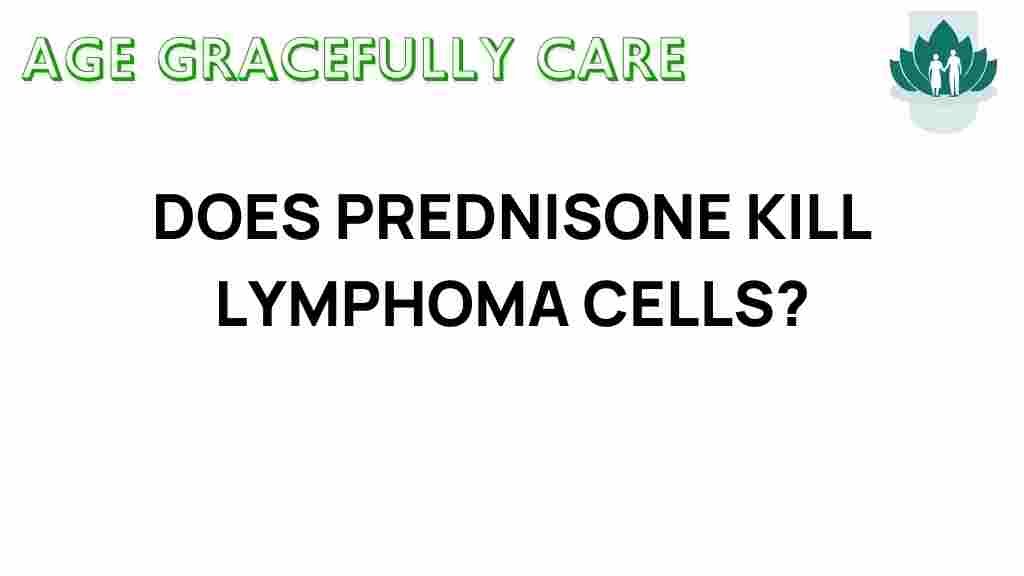Unraveling the Mystery: Does Prednisone Kill Lymphoma Cells?
In the complex landscape of cancer treatment, the role of various medications can often be perplexing. One such medication that has garnered attention in oncology is prednisone, a type of corticosteroid. As patients and researchers alike seek effective methods to combat lymphoma and other cancers, the question arises: does prednisone actually kill lymphoma cells? This article aims to explore the relationship between prednisone and lymphoma, focusing on its efficacy in cancer treatment, immune response modulation, and its place within the broader context of chemotherapy and cancer research.
The Role of Prednisone in Cancer Treatment
Prednisone is a synthetic corticosteroid that mimics the effects of hormones produced by the adrenal glands. It is widely used in various medical conditions, including autoimmune disorders and allergies, but its role in oncology is particularly noteworthy.
How Prednisone Works
Prednisone works by suppressing the immune response and reducing inflammation. In the context of cancer treatment, it can help manage symptoms and side effects associated with chemotherapy, such as:
- Reducing nausea
- Alleviating pain and discomfort
- Decreasing inflammation
However, the question remains whether prednisone can directly kill lymphoma cells. Research indicates that while prednisone does not kill cancer cells outright, it may enhance the efficacy of other treatments.
Prednisone and Immune Response
The immune response plays a crucial role in the body’s ability to fight cancer. Prednisone modulates the immune system, which can be a double-edged sword. On one hand, it may help to reduce the inflammation that can exacerbate symptoms of lymphoma. On the other hand, it can suppress the immune system’s ability to target and destroy cancer cells.
Understanding Lymphoma and Its Treatment
Lymphoma is a type of cancer that originates in the lymphatic system, which is a key component of the immune system. There are two primary types of lymphoma: Hodgkin lymphoma and non-Hodgkin lymphoma. Treatment options vary based on the type and stage of the disease but often include:
- Chemotherapy
- Radiation therapy
- Immunotherapy
- Stem cell transplant
Prednisone is frequently used as part of chemotherapy regimens, particularly in non-Hodgkin lymphoma. Its ability to enhance the efficacy of other drugs makes it a valuable component of treatment.
The Efficacy of Prednisone in Lymphoma Treatment
While prednisone alone is not a cure for lymphoma, its inclusion in treatment protocols can increase overall treatment efficacy. Studies have shown that corticosteroids like prednisone can:
- Improve response rates to chemotherapy
- Reduce the risk of chemotherapy-related side effects
- Help in managing aggressive forms of lymphoma
In particular, prednisone is often used in combination with other chemotherapeutic agents to maximize the treatment response. This synergistic effect can lead to better outcomes for patients.
Chemotherapy and Prednisone: A Synergistic Approach
Chemotherapy is a cornerstone of lymphoma treatment. Prednisone is often included in chemotherapy regimens due to its ability to:
- Enhance the effectiveness of other chemotherapy drugs
- Mitigate side effects, such as nausea and vomiting
- Help with the management of tumor-related symptoms
By understanding the interactions between prednisone and chemotherapy agents, oncologists can tailor treatment plans that maximize the potential for remission and recovery.
Current Research and Findings
Ongoing cancer research continues to investigate the role of corticosteroids, including prednisone, in lymphoma treatment. Some key findings include:
- Studies suggest that prednisone may increase the sensitivity of lymphoma cells to chemotherapeutic agents.
- Research is exploring optimal dosing strategies to balance efficacy and side effects.
- Clinical trials are assessing the impact of corticosteroids on long-term outcomes in lymphoma patients.
As cancer research evolves, new insights may further clarify the role of prednisone in lymphoma treatment, paving the way for improved therapeutic strategies.
Potential Side Effects of Prednisone
While prednisone can be beneficial in cancer treatment, it is also associated with several side effects. Common side effects include:
- Weight gain
- Increased appetite
- Sleep disturbances
- Increased susceptibility to infections
Long-term use of prednisone can lead to more serious complications, such as osteoporosis and adrenal suppression. Therefore, oncologists must carefully weigh the benefits and risks when incorporating prednisone into treatment plans.
Troubleshooting Tips for Patients
For patients undergoing treatment that includes prednisone, here are some tips to manage side effects and maximize treatment efficacy:
- Maintain a balanced diet: Focus on nutrient-rich foods to counteract weight gain and maintain energy levels.
- Stay active: Engage in light exercise to help manage weight and improve mood.
- Monitor side effects: Keep a journal to track any side effects experienced and discuss them with your healthcare provider.
- Stay informed: Research and understand your treatment plan, including the role of prednisone in your regimen.
Being proactive can help patients navigate their treatment journey more effectively.
Conclusion: The Future of Prednisone in Lymphoma Treatment
In summary, while prednisone does not directly kill lymphoma cells, it plays a significant role in enhancing treatment efficacy when used in conjunction with chemotherapy. Its ability to modulate the immune response and alleviate side effects makes it a valuable tool in the oncologist’s arsenal.
As research continues to evolve, understanding the nuances of prednisone’s role in cancer treatment will be crucial for improving patient outcomes. For those navigating the complexities of lymphoma treatment, staying informed and engaged with healthcare providers is essential.
For further information on cancer treatments, visit Cancer.gov. To learn more about the effects of prednisone, check out this research article.
This article is in the category Health and created by AgeGracefullyCare Team
